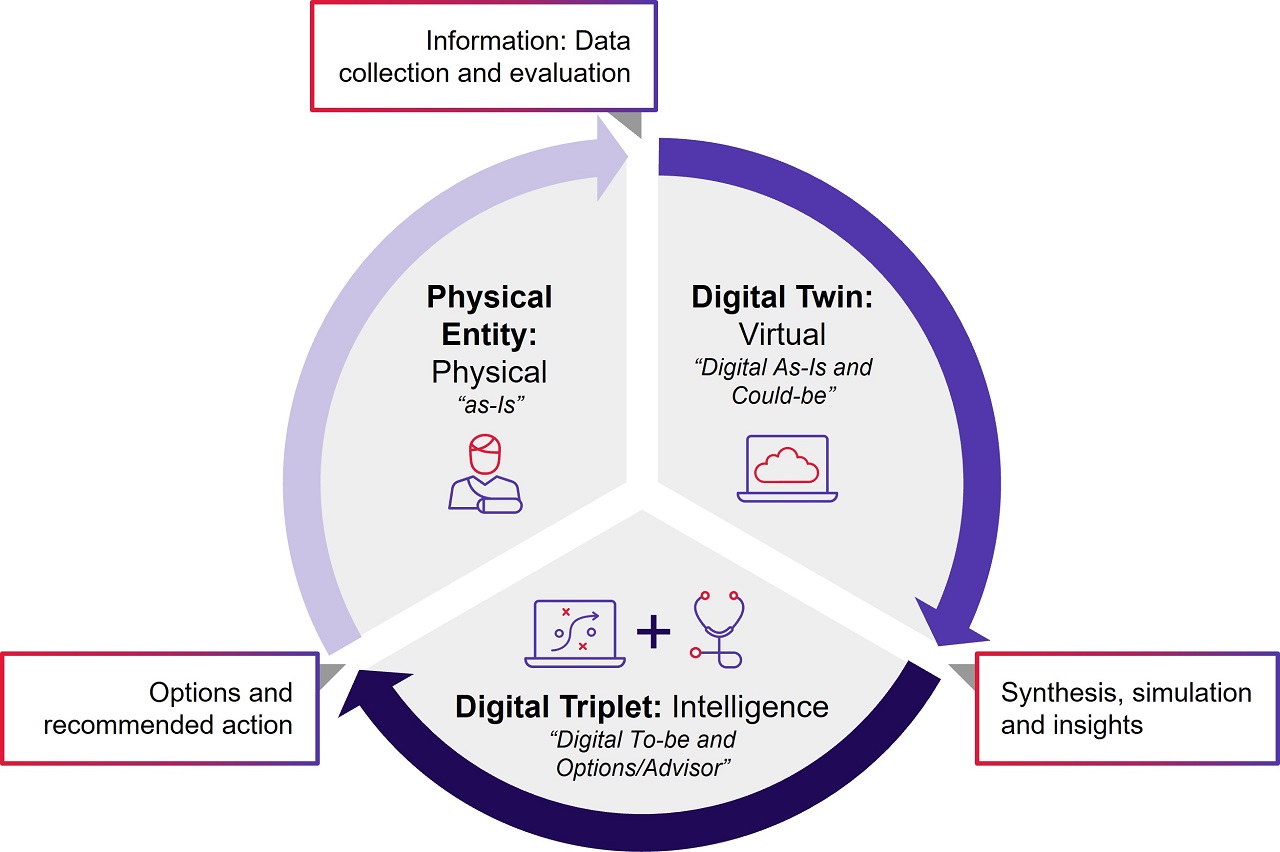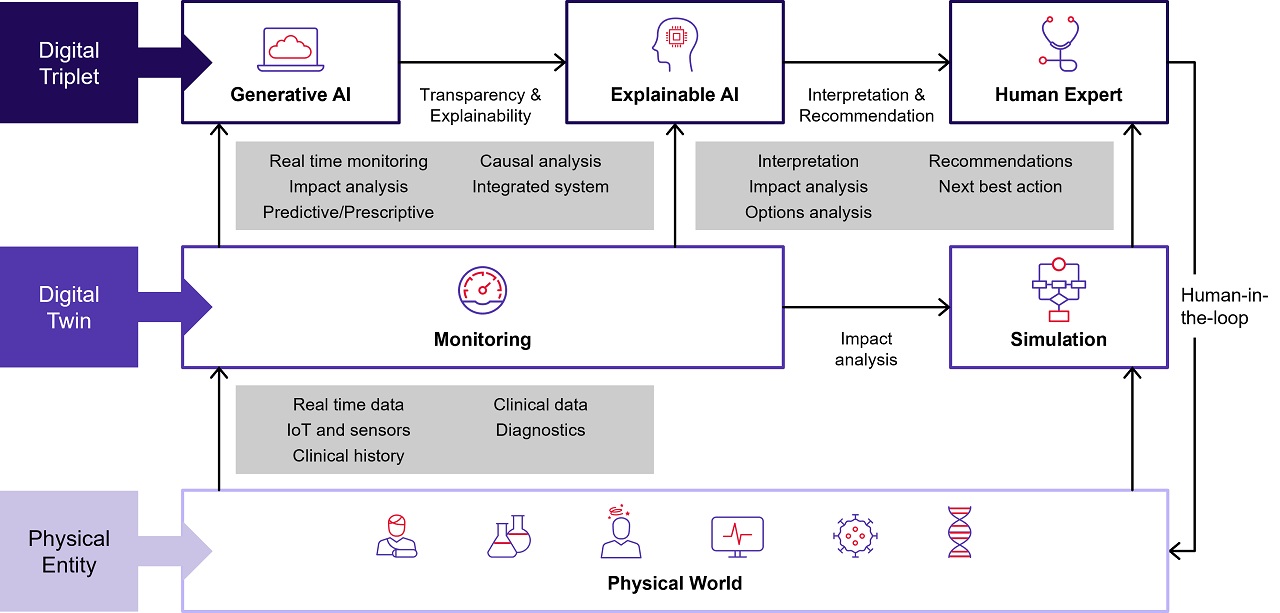Advancements in artificial intelligence (AI) and machine learning have been transforming business operations across industries over the past three decades. Used responsibly, these technologies enable innovative solutions for evidence-based decision-making, predictive and prescriptive actions, intelligent automation and robotics to achieve trusted outcomes.
However, in applying AI, organisations face challenges in terms of usability, interpretability, and the end user experience. Such challenges require innovative approaches, and this is where digital triplets come into play.
What is a digital triplet?
A digital triplet extends the digital twin model to enable a decision-maker to use advancements in AI to interrogate the digital twin data. This includes the ability to request more situational information and to simulate and optimise outcomes under different scenarios.
The term digital triplet was first introduced in 2019 as a framework for combining the digital twin with two AI components—one for generating and comparing scenarios and another for explaining and justifying the recommendations. The concept was further developed in 2020 and applied in the context of precision medicine and chronic disease management.
CGI’s digital triplet approach applies AI-driven analysis to increase the usability and interpretability of the insights. By synthesizing data quickly and communicating outcomes clearly, digital triplets help organisations improve decision-making.
The objective is to enhance both the AI capabilities and the human-AI interaction across multiple sectors. This allows for more personalised, evidence-based, and transparent decision-making and recommendations. In this way, the digital triplet serves as a virtual third-party advisor to the digital twin end user or decision-maker.
CGI’s Digital Triplet Approach: Third-party advisor for decision-makers
As shown above, a digital triplet has three core components:
- The physical entity, the entity being evaluated to improve the function or outcomes.
- The digital twin, which models the physical entity using data-driven and knowledge-based methods. It integrates real-time and in-context data from various sources (e.g., operations, equipment, devices and media) to help decision-makers better understand the current (as-is) and future (could-be) states of a target physical entity. The digital twin predicts the effects of different scenarios to improve risk mitigation and shape the desired future state.
- The digital triplet, the intelligent advisor using generative AI (GenAI) and explainable AI (XAI) to allow the user to interrogate the digital twin to make complex decisions.
Today, digital twins help researchers conduct experiments and test hypotheses via computer simulation, without exposing the real entity to any risks or harm. Therefore, they are powerful tools for predictive maintenance, algorithmic operations, evidence-based decision-making, and more.
However, a digital twin alone may not be sufficient to provide optimal guidance for decision-makers who need to consider the implications of the information provided—not only the current and future state of a physical entity, but also the trade-offs, uncertainties, and preferences involved in making complex decisions related to that entity.
The digital triplet extends the digital twin to compare scenarios and make recommendations
The digital triplet adds another layer of AI to generate and compare multiple scenarios, recommend the next best actions (options/advisor), interpret outcomes of scenarios in multiple states and contexts, and explain the reasoning behind digital twin interpretations. It can also provide more context for any resulting recommendations.
Additionally, the digital triplet enables interactions and scenario evaluations to be conducted in natural language through text or speech. It thus acts as an intelligent assistant, a virtual third-party advisor, that supports the human expert in making the best possible choices for any scenario.
Digital Triplet Interactions
Examples of digital triplets in action
While a relatively new concept, the digital triplet is not merely theoretical. It is a practical solution that has been implemented across multiple environments. For example:
- At Google Cloud AI Live + Labs in Montreal in 2023, CGI demonstrated a digital triplet to extend computer visioning for train, rail, or locomotive alerts, as well as provide context and recommended next best actions to engineers and conductors.
- The European Union's VirtualBrainCloud project aims to develop a digital twin for patients with neurodegenerative diseases, such as Alzheimer's or Parkinson's, and use a digital triplet to support personalised diagnosis, prognosis, and treatment.
- Another example is using a digital triplet to improve the treatment of heart failure. Philips and the Mayo Clinic developed a digital twin of the human heart that can be adjusted for each patient based on data from various sources, such as medical imaging and electronic health records. The digital triplet then uses GenAI to test how different treatments and interventions would affect the patient’s heart, helping doctors to choose the best treatment option. XAI is used to share the results and recommendations with patients and their healthcare providers in a clear and understandable way.
- Waygate Technologies is using the digital triplet to detect defaults in industrial inspections increasing the reliability of equipment such as aircraft.
Limitless possibilities to increase trusted outcomes
The possibilities for using digital triplets to provide expert advice to business users is unlimited. The technology supports the analysis and investigation process and communicates the outcomes in a practical and conversational approach. This allows the user or decision-maker to vary the scenarios and ask validating and alternate criteria questions in natural language. The digital triplet contains the business context and reference information available and synthesizes the information quickly to explore options in partnership with the user.
Opportunities include:
- Improving the quality of operations and service delivery by giving customised, evidence-based, and proactive advice for users and decision-makers.
- Enhancing the decision-making process by considering multiple factors and outcomes, examining different options, and explaining the reasons and trade-offs.
- Strengthening the human expert by boosting their abilities, adding to their expertise, and supporting their independence and creativity.
- Building trust and collaboration between humans and AI by creating a common understanding, encouraging a dialogue, and respecting the values and preferences of both parties.
- Advancing the knowledge of industry experts by creating new hypotheses, testing new interventions, and finding new insights from the data and the models and increasing the value of the digital twin investment.
The power of GenAI is becoming clear as virtual AI-powered assistants are entering the everyday lives of citizens, customers and employees—for example, Microsoft Copilot, image and video generators. CGI’s digital triplet solution extends those capabilities to not just act as an advisor, but to also embody a multi-model ecosystem founded upon responsible AI principles to provide increased functionality and increase the value of existing and new digital twin investments.
A digital triplet presents a great opportunity for organisations to apply human-AI collaboration and create trusted outcomes at scale. Organisations must start envisioning, exploring, engineering and expanding their capabilities with digital triplets.
Want to start a conversation? Feel free to contact me for a discussion or read more about our approach and additional industry use cases on our digital triplet page. I also invite you to read about a recent discussion my colleague Fred Miskawi and I had with Technology Business Research, Inc., about digital triplets and other GenAI topics in “Research firm TBR spotlights CGI’s GenAI capabilities.”
Back to top






